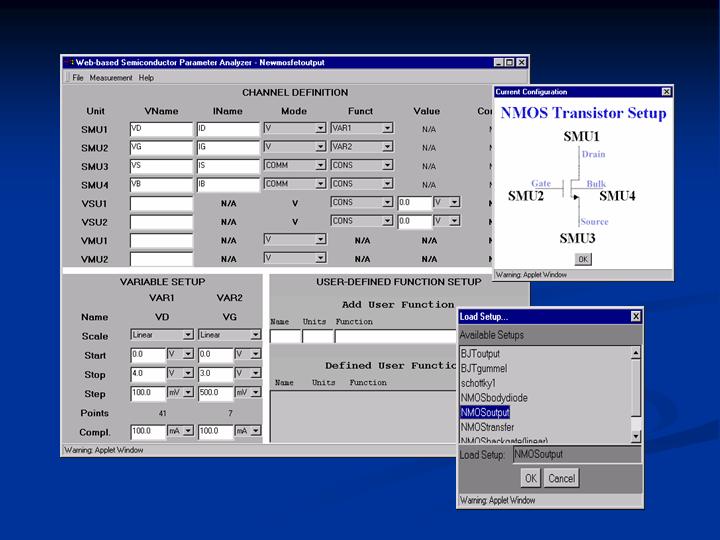iLab: If you can't come to the lab... the lab will come to you!
|
 Prof. Jesús A. del Alamo - Dept. of Electical Engineering and Computer Science (EECS)
Prof. Jesús A. del Alamo - Dept. of Electical Engineering and Computer Science (EECS)Students are more motivated and can learn more effectively if they have the opportunity to conduct experiments. Experiments allow a student to compare reality with simulations, collaborate with each other, and give them opportunity follow their curiosity. However, Many engineering classes do not include a lab component because of significant expense and space considerations.
In response to this, iLab is creating remote web-accessible laboratories that will provide a new framework science and engineering courses. Remote laboratories allow for much more efficient use of laboratory equipment and give students the opportunity to conduct experiments from the comfort of an Internet accessible browser. iLab began with the microelectronics "weblab," and is rapidly expanding to include the chemical reactor weblab, mechanical structures weblab, heat exchanger weblab, and an instrumentalized flagpole.
Conventional courses in microelectronics device physics rarely include a laboratory experience because in a class of more than a dozen students, equipment, space, training, safety, and staffing constraints become nearly insurmountable. Prof. del Alamo designed the microelectronics weblab to bring the laboratory experience to these classes. Weblab allows students to enter their design/ modifications to a transistor from their computer, then test it using expensive equipment in a remote laboratory using a web interface. This not only gives students experimental data to work with, but also optimizes the use of the equipment. The weblab queuing system allows several students to use the same equipment at virtually the same time.
The MicroElectronice WebLab has been used in course 6.012, "Microelectronics Devices and Circuits", 6.720J/3.43J "Integrated Microelectronics Devices", SMA5104 "Fundamentals of Semiconductor Device Physics". SMA5104 was taught for about 20 graduate students in Singapore as part of the Singapore-MIT Alliance. The lab, the instructor and the TA from the course were all at MIT. One of the students from Singapore reports, "I think this is a great exercise. It allows us to compare real data with the modeled one. In doing so, I realize that the model is in fact quite simplified."
In the Fall of 2000 students in 6.720J/3.43J "Integrated Microelectronic Devices" characterized state-of-the-art hardware through a prototype weblab system installed at Compaq. The 0.18 um CMOS is the latest and fastest CMOS technology generation that has recently been deployed in the real world. This technology is enabling microprocessors with clock speeds exceeding 1 GHz. 0.18. um technology Si wafers are "too hot to handle" and are closely guarded. Having a wafer on campus was clearly out of question due to IP concerns. With the initiative of Ted Equi of Compaq, the researchers were able to install a copy of the MIT Microelectronics weblab at Compaq's Alpha Development Group center in Shrewsbury, MA. Through this system, 6.720J/3.43J students accessed the latest CMOS hardware that Compaq's designers are currently working with. Students were able to take remote measurements in real time and download the data. They were also able to compare the state-of-the-art technology with the 10-year old hardware that is available through the on-campus WebLab.
Current work on the Microelectronics web lab includes developing an integrated simulation tool that simplifies the mechanical aspects of data handling but preserves the educational goals of comparing data and theory.
Mechanical Structures WeblabWork has begun to design a structural mechanics weblab and implement remote weblab experimentation in the new Aeronautics and Astronautics curriculum, from core undergraduate subjects to advanced graduate level classes.
Heat Exchanger WeblabCreate heat transfer experiment for the online use in lectures in course 10.302 "Transport Processes".
Instrumentalized FlagpoleMany forces that effect the stability of large structures, like office buildings and suspension bridges. The instrumentalized Flagpole allows students to investigate these forces by looking at the most basic of structures--the flagpole. Outfitted with sensors that measure temperature, movement, and stress, the flagpole that stands in MIT's Killian Court streams information back to the lab where it can be monitored in real-time, analyzed and stored. Students are then able to compare theoretical data with real data and learn to manage and describe the discrepancies. The Instrumentialized Flagpole has been used in the classes 1.120 (Civil Eng. M.Eng. Project), 1.124 (Software Engineering), 1.130 (Wavelet Analysis) and 1.030 (Civil Eng. Materials).